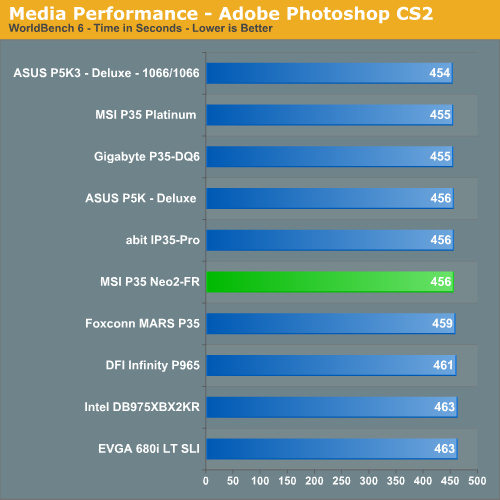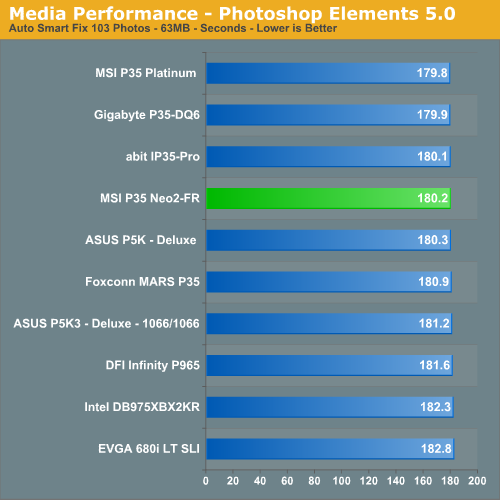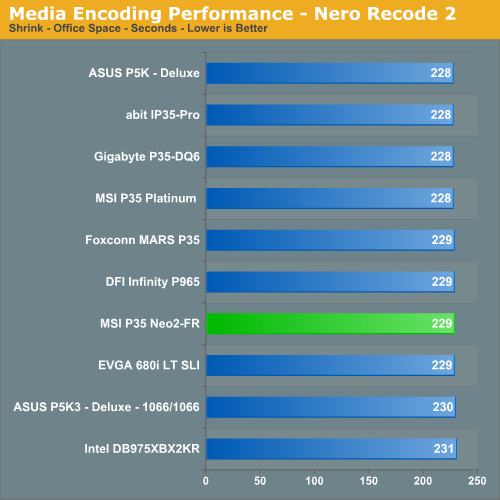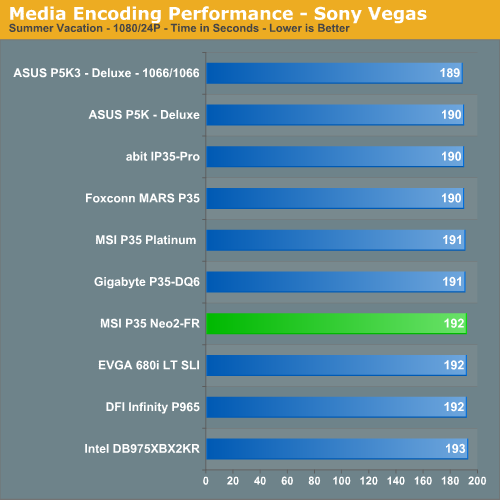MSI P35 Neo2-FR: Platinum performance for under $100
by Gary Key on December 5, 2007 11:00 PM EST- Posted in
- Motherboards
Media Performance
We will take a brief look at general media performance with our test suite that includes Adobe Photoshop CS2 and Adobe Photoshop Elements 5.0. We utilize the PC WorldBench 6.0 Test for measuring platform performance in Adobe's Photoshop CS2. The benchmark applies an extensive number of filters to the test image and heavily stresses the CPU and storage systems. The scores reported include the full conversion process and are in seconds, with lower numbers indicating better performance.

This test requires a balance between CPU speed and a fast storage subsystem. The Neo2-FR board scores within two seconds of the top board.
Our next test is one recommended by Intel, but the test itself appears to be fair and results are very repeatable. This test simply measures the amount of time required to fix and optimize 103 different photos weighing in at 63MB. We report results in seconds, with lower times indicating better performance

The Neo2-FR board scores well in this CPU intensive test and is only 0.4 seconds slower than its big bother. With the memory timings set identically, the board is just as fast as the Platinum version.
Media Encoding Performance
We are utilizing Nero Recode 2 and Sony Vegas 7.0e for our video encoding tests. The scores listed include the full encoding process represented in seconds, with lower numbers indicating better performance.
Our first series of tests is quite easy - we take our original Office Space DVD and use AnyDVD to rip the full DVD to the hard drive without compression, thus providing an almost exact duplicate of the DVD. We then fire up Nero Recode 2, select our Office Space copy on the hard drive, and perform a shrink operation to allow the entire movie along with extras to fit on a single 4.5GB DVD disc. We leave all options on their defaults except we uncheck the advanced analysis option.

We find in this CPU and disk intensive test that all of the boards are within 1% of each other with the Neo2-FR board finishing one second slower than the fastest boards. Over the course of a year, that difference might add up to an extra five minutes of your life back. However, if you are burning that many DVDs, you are probably in need of much more than five minutes of saved time.
Our Sony Vegas 7.0e test converts several of our summer vacation files into a plasma-screen-pleasing 1080/24P format with a 5.1 audio stream. We ensure our quality settings are set to their highest levels and then let the horses loose.

In a test that really stresses the CPU and memory subsystem, we see the Neo2-FR board trailing the other P35 boards. This result once again confirms the slower memory timings make a difference, however slight - 1.5% in this case.










35 Comments
View All Comments
DigitalFreak - Thursday, December 6, 2007 - link
I sincerely hope that the USB port block on the back is supported by more than just that tiny riser. That thing looks like it would break off if you looked at it funny.Griswold - Thursday, December 6, 2007 - link
Nothing to worry about, unless some clumsy fool or 8 year old child rams the USB plug in.superkdogg - Thursday, December 6, 2007 - link
Reading the introduction about the surprising performance of the new MSI board got my ears up, but then I read the article and it was more of the same.Every motherboard performs virtually the same these days at stock speeds. The only things that differentiate anything is overclocking/bios, reliability, layout, price, extra features (if you need them), and personal brand preference.
Motherboard 'reviews' could pretty much be replaced by a table that tells a consumer about those things above. Benchmarking showing that everything is +/- 2% from the median just eats up space.
j@cko - Thursday, December 6, 2007 - link
LOL. I totally agree with ya. Motherboard review nowadays is more about reliability and overclockability, I think.JarredWalton - Thursday, December 6, 2007 - link
The problem is, if we were to eliminate all of the benchmarking, how do we really know if a board is reliable? If you haven't noticed, 90% or something of the text on the benchmark pages is filler - the graphs pretty much say everything you need to know. Anyway, doing motherboard reviews can be a thankless endeavor, but we still think it's necessary. We're not quite at the "necessary evil" stage either. :)brian_riendeau - Thursday, December 6, 2007 - link
Its quite easy really to show the effectiveness of a mobo design without wasting 5 pages on graphs that show no difference between 10 models of motherboards.Test the motherboards in harsh environments. No one really cares if their board is 1% faster than another board, however they will care if their whole system crashes repeatedly if their AC goes out and the room temp gets up to 90F.
drebo - Thursday, December 6, 2007 - link
Death of the P35 Neo-F, one of the best mid-range boards ever made. For $85 you get a superb P35 board, but they're not making it anymore. Moving to this board, you lose Parallel and Serial ports, which for many general home users are very important.Intel doesn't make a P35 board with parallel or serial, and ASUS's P5K board is about $40 more expensive. I really wish a tier 1 manufacturer would come out with another good board. The last couple generations it's been MSI, with the P965 Neo3-F and then the P35 Neo-F. Looks as though there won't be a P35 Neo2-F, unfortunately. They're making a hybrid DDR2/DDR3 board instead, which neuters any kind of RAM upgrades for the end users because you can only use one or the other, not both, and neither in a dual-channel configuration.
Oh well. Maybe ASUS will drop the price of their P5K board.
Ratinator - Thursday, December 6, 2007 - link
[quote]Moving to this board, you lose Parallel and Serial ports, which for many general home users are very important. [/quote]Did you mean not very important?
drebo - Thursday, December 6, 2007 - link
No, I didn't. You'd be surprised how many people at home have serial mice they don't want to replace (old trackballs that they're too stubborn to get rid of) and parallel printers. A lot of people in the business world need them, too. They need parallel for printers and serial to run machines off of, or for their PDAs, or for other reasons.There needs to be a good midrange board that still supports these legacy devices, and with the P35 Neo-F going by the wayside, that board just doesn't exist anymore.
brian_riendeau - Thursday, December 6, 2007 - link
I am sorry to inform you of this, however not many people shopping for new motherboards for business or personal use care about serial and parallel ports. You just gotta let things go man... Anyone who really needs to use a legacy port can pickup USB port -> legacy port adapters for cheap if they really need to use old hardware. We have a whole department of people where I work still chained to serial devices, however they all have C2D and Quad core PCs now and just use USB adapters.